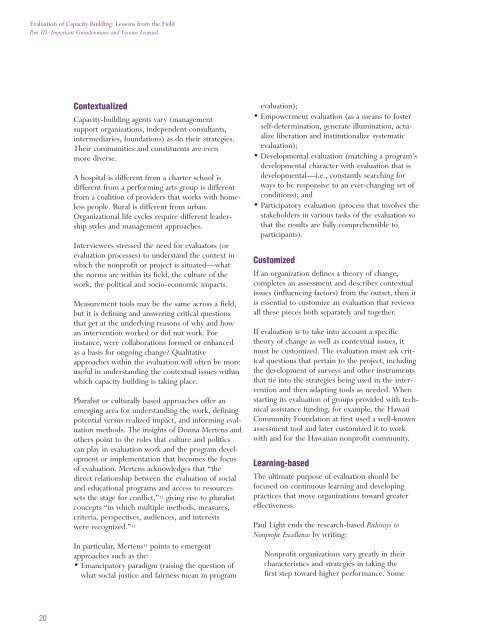Lessons from the Field - Seer Consulting
Lessons from the Field - Seer Consulting
Lessons from the Field - Seer Consulting
Create successful ePaper yourself
Turn your PDF publications into a flip-book with our unique Google optimized e-Paper software.
Evaluation of Capacity Building: <strong>Lessons</strong> <strong>from</strong> <strong>the</strong> <strong>Field</strong><br />
Part III: Important Considerations and <strong>Lessons</strong> Learned<br />
20<br />
Contextualized<br />
Capacity-building agents vary (management<br />
support organizations, independent consultants,<br />
intermediaries, foundations) as do <strong>the</strong>ir strategies.<br />
Their communities and constituents are even<br />
more diverse.<br />
A hospital is different <strong>from</strong> a charter school is<br />
different <strong>from</strong> a performing arts group is different<br />
<strong>from</strong> a coalition of providers that works with homeless<br />
people. Rural is different <strong>from</strong> urban.<br />
Organizational life cycles require different leadership<br />
styles and management approaches.<br />
Interviewees stressed <strong>the</strong> need for evaluators (or<br />
evaluation processes) to understand <strong>the</strong> context in<br />
which <strong>the</strong> nonprofit or project is situated—what<br />
<strong>the</strong> norms are within its field, <strong>the</strong> culture of <strong>the</strong><br />
work, <strong>the</strong> political and socio-economic impacts.<br />
Measurement tools may be <strong>the</strong> same across a field,<br />
but it is defining and answering critical questions<br />
that get at <strong>the</strong> underlying reasons of why and how<br />
an intervention worked or did not work. For<br />
instance, were collaborations formed or enhanced<br />
as a basis for ongoing change? Qualitative<br />
approaches within <strong>the</strong> evaluation will often be more<br />
useful in understanding <strong>the</strong> contextual issues within<br />
which capacity building is taking place.<br />
Pluralist or culturally based approaches offer an<br />
emerging area for understanding <strong>the</strong> work, defining<br />
potential versus realized impact, and informing evaluation<br />
methods. The insights of Donna Mertens and<br />
o<strong>the</strong>rs point to <strong>the</strong> roles that culture and politics<br />
can play in evaluation work and <strong>the</strong> program development<br />
or implementation that becomes <strong>the</strong> focus<br />
of evaluation. Mertens acknowledges that “<strong>the</strong><br />
direct relationship between <strong>the</strong> evaluation of social<br />
and educational programs and access to resources<br />
sets <strong>the</strong> stage for conflict,” 12 giving rise to pluralist<br />
concepts “in which multiple methods, measures,<br />
criteria, perspectives, audiences, and interests<br />
were recognized.” 13<br />
In particular, Mertens 14 points to emergent<br />
approaches such as <strong>the</strong>:<br />
• Emancipatory paradigm (raising <strong>the</strong> question of<br />
what social justice and fairness mean in program<br />
evaluation);<br />
• Empowerment evaluation (as a means to foster<br />
self-determination, generate illumination, actualize<br />
liberation and institutionalize systematic<br />
evaluation);<br />
• Developmental evaluation (matching a program’s<br />
developmental character with evaluation that is<br />
developmental—i.e., constantly searching for<br />
ways to be responsive to an ever-changing set of<br />
conditions); and<br />
• Participatory evaluation (process that involves <strong>the</strong><br />
stakeholders in various tasks of <strong>the</strong> evaluation so<br />
that <strong>the</strong> results are fully comprehensible to<br />
participants).<br />
Customized<br />
If an organization defines a <strong>the</strong>ory of change,<br />
completes an assessment and describes contextual<br />
issues (influencing factors) <strong>from</strong> <strong>the</strong> outset, <strong>the</strong>n it<br />
is essential to customize an evaluation that reviews<br />
all <strong>the</strong>se pieces both separately and toge<strong>the</strong>r.<br />
If evaluation is to take into account a specific<br />
<strong>the</strong>ory of change as well as contextual issues, it<br />
must be customized. The evaluation must ask critical<br />
questions that pertain to <strong>the</strong> project, including<br />
<strong>the</strong> development of surveys and o<strong>the</strong>r instruments<br />
that tie into <strong>the</strong> strategies being used in <strong>the</strong> intervention<br />
and <strong>the</strong>n adapting tools as needed. When<br />
starting its evaluation of groups provided with technical<br />
assistance funding, for example, <strong>the</strong> Hawaii<br />
Community Foundation at first used a well-known<br />
assessment tool and later customized it to work<br />
with and for <strong>the</strong> Hawaiian nonprofit community.<br />
Learning-based<br />
The ultimate purpose of evaluation should be<br />
focused on continuous learning and developing<br />
practices that move organizations toward greater<br />
effectiveness.<br />
Paul Light ends <strong>the</strong> research-based Pathways to<br />
Nonprofit Excellence by writing:<br />
Nonprofit organizations vary greatly in <strong>the</strong>ir<br />
characteristics and strategies in taking <strong>the</strong><br />
first step toward higher performance. Some


